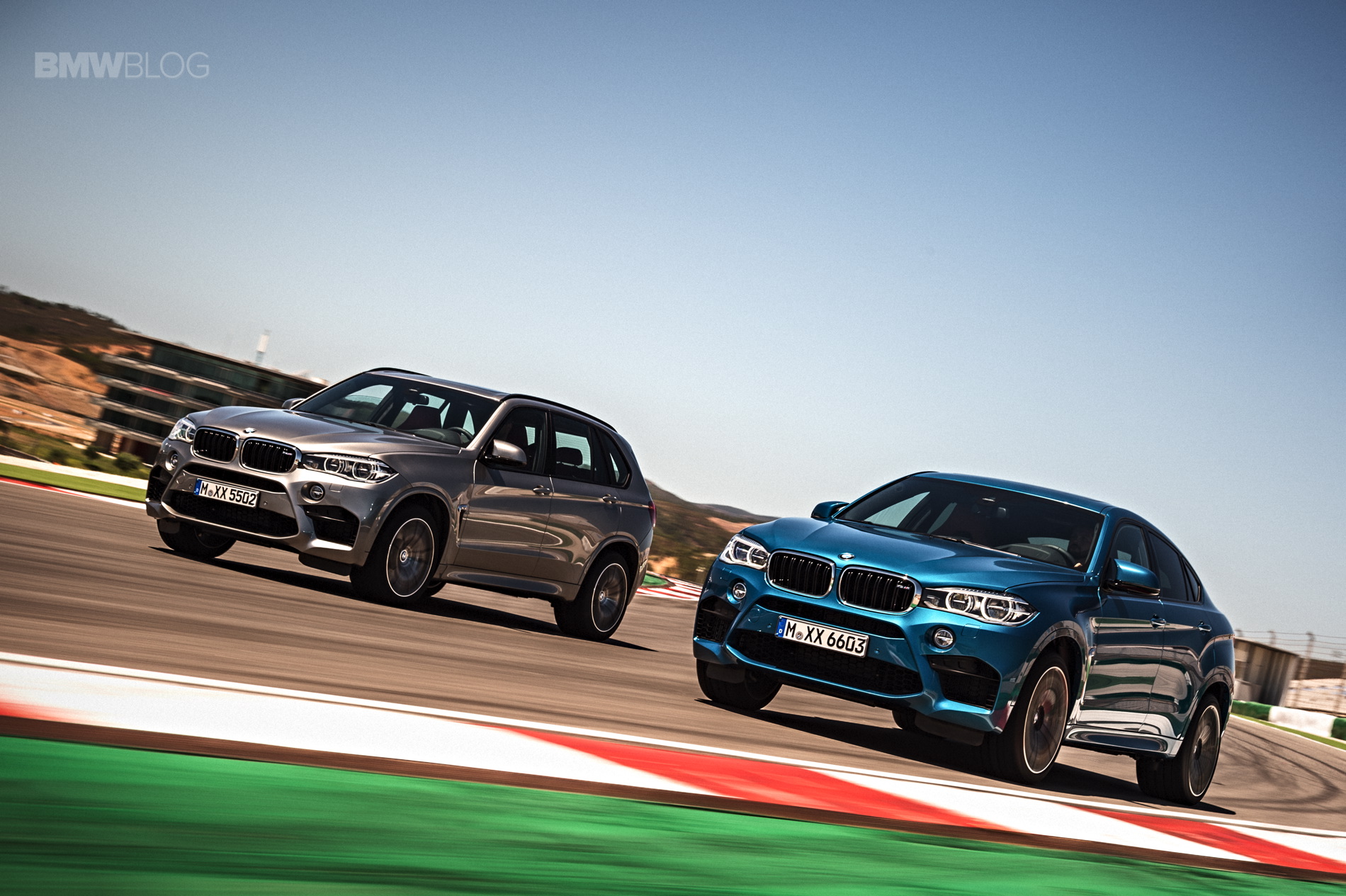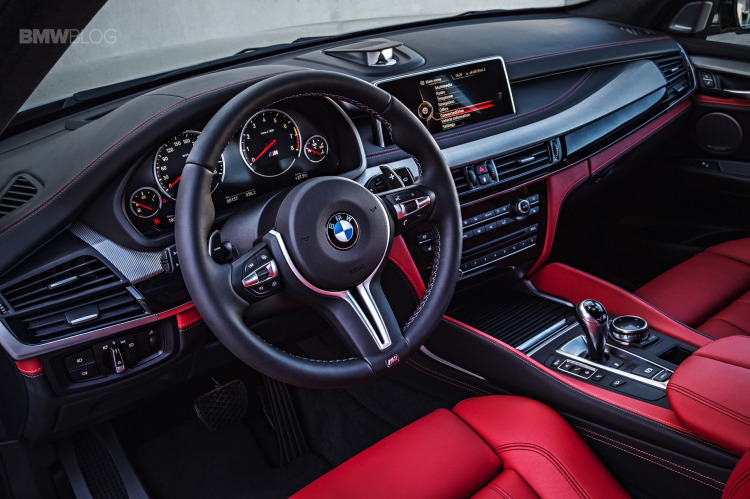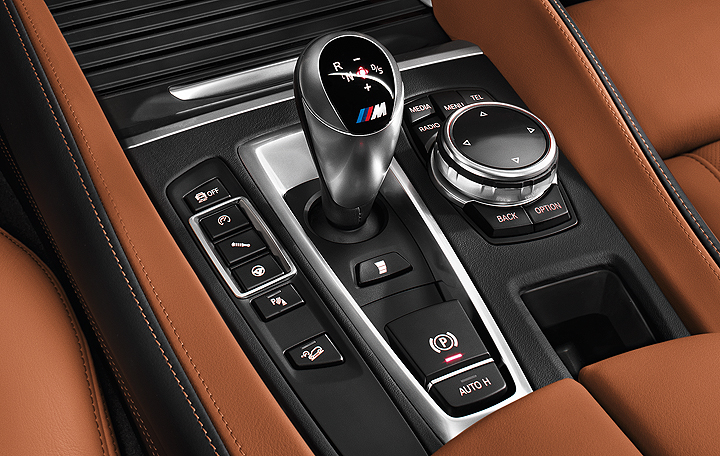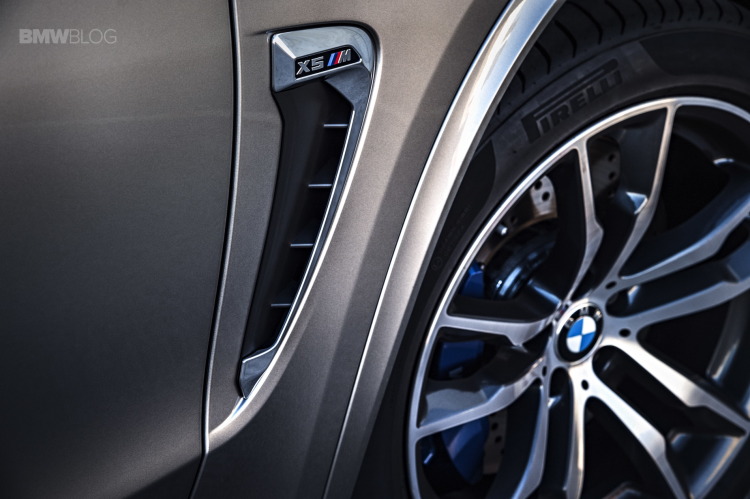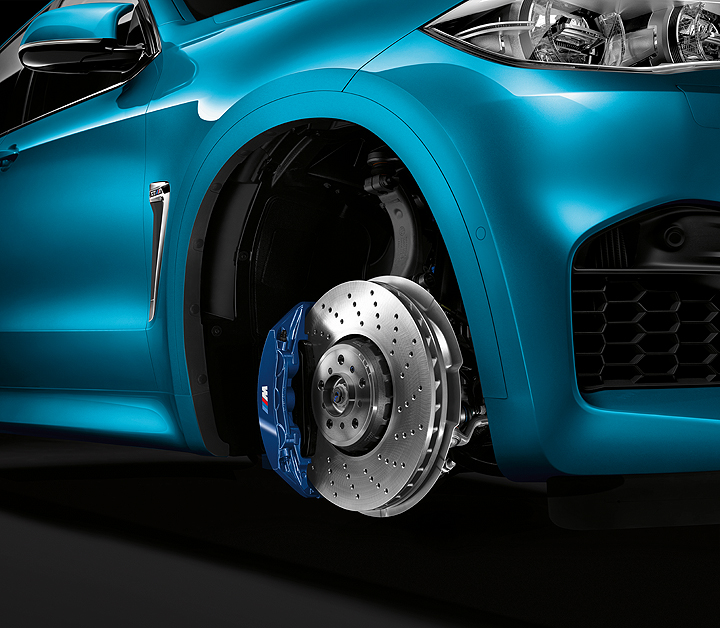These are the full technical specs for the new BMW X5 M and BMW X6 M.
The Engine
The new M TwinPower Turbo engine for the BMW X5 M and BMW X6 M is the most powerful unit ever developed by BMW for an all-wheel-drive vehicle. Boasting innovative M TwinPower Turbo technology with a pair of TwinScroll turbochargers, cross-bank exhaust manifolds, VALVETRONIC and High Precision Direct Petrol Injection, the 4.4-litre V8 produces maximum output of 423 kW/575 hp between 6,000 and 6,500 rpm. That represents a four per cent increase over the predecessor models. The step up is even clearer when it comes to the power development of the new engine.
Peak torque has been boosted by 70 Nm (52 lb-ft), which equates to a rise of 10 per cent. Ist 750 Nm (553 lb-ft) can be enjoyed across a broad rev range between 2,200 and 5,000 rpm.
At the same time, fuel consumption of the new BMW X5 M and BMW X6 M in the EU cycle has been cut by 20 per cent – from 13.9 l/100 km (20.3 mpg imp) to 11.1 l/100 km (25.5 mpg imp). CO2 emissions are likewise down by more than 20 per cent, to 258 g/km. The two models accelerate from 0 to 100 km/h (62 mph) in 4.2 seconds through the standard eightspeed M Steptronic transmission with Drivelogic. Top speed is limited to 250 km/h (155 mph).
The new BMW X5 M and new BMW X6 M send their engine power to the wheels via the newly developed eight-speed M Steptronic transmission with Drivelogic, which mirrors the operating concept of the M Double Clutch Transmission used by other M models. With its instantaneous responses, rapid gear changes and super-direct reaction to load changes, the torque converter auto links up seamlessly with the new higher-torque turbocharged engine and showcases its talents in hugely impressive style. At the same time, its wider ratio spread allows it to offer a clear drop in fuel consumption over the six-speed transmission of the previous-generation cars, as well as an increase in driving comfort and improved performance. This is also the first torque converter to enable “creep on demand” through the Low Speed Assistant.
The new eight-speed M Steptronic transmission allows drivers to sit back and enjoy automatic shifts or change gear manually using the gearshift paddles on the M leather steering wheel. And for the perfect getaway, the driver can activate the Launch Control system adapted from use in racing cars. Here, the driver keeps their foot on the brakes and pushes the accelerator down almost to the floor, which prompts the system to dial in the ideal getaway rpm. Releasing the brakes prompts Launch Control to let the car off the leash, and it accelerates off the line with maximum propulsion.
The driver can also use the three-stage Drivelogic function to choose whether to prioritise fuel economy, comfort or sports performance. This function is available both in automatic mode and in sequential SPORT mode.
BMW xDrive intelligent all-wheel drive and Dynamic Performance Control play a key role in the outstanding dynamics of the new BMW X5 M and new BMW X6 M. The xDrive system employs an electronically controlled multiplate clutch to allow fully variable distribution of drive between the front and rear axles – from 100 per cent at the rear to up to 100 per cent at the front. This ensures the best possible traction in all road conditions. In the interests of greater agility, xDrive brings a rear-biased basic set-up to the BMW X5 M and BMW X6 M.
The driving dynamics system Dynamic Performance Control oversees the continuous distribution of drive between the rear wheels – both under load and on the overrun – regardless of engine output. Working in combination with the xDrive all-wheel-drive system, the result is a whole new bracket of dynamic flair, agility and traction. The car follows the course set by the driver far more accurately, whatever the road surface, and the system also reduces the amount of wheel work required of the driver: the steering responds more directly and far fewer corrections are necessary. Moreover, the inherent propensity of conventional all-wheel-drive vehicles to understeer is eliminated. An improvement in traction is also impressively noticeable (on road surfaces with differing friction levels, in particular), and active safety is markedly enhanced as a result. The driver can see how Dynamic Performance Control is operating on the display, with arrows at all four wheels visualising where the engine power is currently being sent.
Among the other highlights of the overall concept behind the new BMW X5 M and new BMW X6 M is Dynamic Stability Control (DSC). The control functions of DSC have been optimised over previous versions of the system to improve driving dynamics further still. Added to which, extra functions enhancing active safety (Brake Standby, Brake Drying, Fading Compensation) and comfort (Start-Off Assistant, parking brake with automatic hold function) have also been introduced.
Dynamic Stability Control allows the driver to choose from three modes: DSC on, MDM (M Dynamic Mode), DSC off. While DSC on counteracts understeer and oversteer to great effect with brake inputs, MDM allows greater wheel slip – to give keen drivers the chance to execute some mild drifts. However, the driver aids will also intervene to assist the driver in this mode if a predefined dynamic limit is exceeded. Deactivating DSC (through DSC off) gives the driver the chance to fully explore the car’s dynamic limits on the track and nudge the car into power oversteer (i.e. a drift) using the accelerator. In this mode, the system will only introduce brake inputs in extreme situations involving significant shifts in lateral acceleration.
The exhaust system has been modified to satisfy the sporting ambitions of the new M models. A distinctively familiar BMW M engine note resonates out across the whole rev range via electrically controlled flaps, which open or close according to demand, and sounds even sportier and emotionally richer than that of its predecessor. Selecting one of the preconfigured driving modes, moreover, engages a finely balanced set-up that also provides acoustic feedback on the engine load at any one time.
The new BMW X5 M and BMW X6 M once again set the pace in the highperformance Sports Activity Vehicle and Sports Activity Coupe segments thanks to extensive chassis upgrades. These combine to provide outstanding dynamics together with unbeatable directional stability and excellent traction, along with the type of neutral self-steering typical of M cars, in particular when accelerating out of corners and toying with the dynamic limits.
o this end, the double-wishbone front suspension features revised kinematics. A modified upper wishbone (increase in camber, optimised camber progression and steering pivot axis) allows a further increase in cornering force potential and agility. At the same time, M-specific elastokinematics with more rigid bearings improve wheel guidance and therefore directional stability – both at the front axle and the Integral-IV rear axle (a spatial suspension system with anti-squat and anti-dive). Firmer suspension spring tuning and a 10-millimetre drop in ride height team up with the Dynamic Drive active roll stabilisation system to bring about an effective reduction in body roll and movement. In addition, the BMW X5 M and BMW X6 M come as standard with air suspension with self-levelling at the rear axle.
Plus, Dynamic Damper Control with electronically adjustable dampers – the driver can select from three modes (COMFORT, SPORT and SPORT+) at the touch of a button – ensures the perfect balance between dynamic flair and ride comfort.
Another central element in the driving characteristics of the new BMW X5 M and BMW X6 M are the special tyres, whose development closely followed that of the axle construction. In the high-performance segment, tyre choice for the front axle focuses – alongside lateral stability and brake forces – primarily on steering precision and feel. By contrast, the engineers’ attention in the development of the rear tyres centred on traction, lateral stability and directional stability. In order to meet these part-contradictory, partcomplementary demands, the BMW M GmbH engineers have developed two sets of mixed tyres for the new BMW X5 M and new BMW X6 M. The interconnected development of tyres, steering and axles endows the new cars with assured handling properties and good rolling comfort.
Both models are fitted as standard with low-weight 20-inch light-alloy wheels (front: 10 J x 20, rear: 11.5 J x 20) with Pirelli P Zero tyres (front: 285/40 R20 Y, rear: 325/35 R20 Y).
Low-weight 21-inch forged wheels (front: 10 J x 21, rear: 11.5 J x 21) with Michelin Pilot Super Sport UHP tyres (front: 285/35 R21 Y, rear: 325/30 R21 Y) can be ordered as an option.
Steering.
One of the most important interfaces between driver and vehicle is the steering. Here, BMW M GmbH’s high-performance models have set the benchmark from day one when it comes to providing a direct steering feel, precise feedback on the driving conditions and a finely-tuned balance when exploring the dynamic limits. Continuing this tradition, the M Servotronic steering in the new BMW X5 M and BMW X6 M – with its M-specific gear ratios and intelligently composed overall set-up – likewise scales these lofty heights. This rack-and-pinion system with electric power assistance uses no energy when the car is travelling straight ahead, and so saves 0.3 litres of petrol per 100 kilometres (62 miles) compared to hydraulic systems.
The Servotronic function familiar from hydraulic systems, which controls the degree of steering assistance according to the car’s speed, is another integral element. Furthermore, drivers can choose from three steering settings (COMFORT, SPORT, SPORT+) – at the touch of a button in the centre console or by storing their preferred settings in the M Drive buttons – to adjust the steering characteristics to personal tastes or the situation at hand.
The remarkable dynamic potential of the BMW X5 M and BMW X6 M is backed up by the standard high-performance compound brakes with large six-piston fixed callipers at the front and single-piston floating callipers at the rear. Excellent stopping power, precise feel, low weight and increased resistance to heat are their headline features. The brake discs in compound systems – which were originally developed for racing – are made up of different parts and materials. The surface of the brake linings is 50 per cent larger compared with those on the predecessor models. At the same time weight is down by 1.6 kilograms, helping to reduce unsprung and rotating masses.
This also feeds into improvements in the acceleration, responsiveness and handling of the BMW X5 M and BMW X6 M. And the compound brakes waste no time in signalling their performance capability visually as well. All the brake discs are perforated and inner-vented, and the brake callipers are painted in Dark Blue metallic, in typical M fashion, and marked at the front wheels with the M logo.
